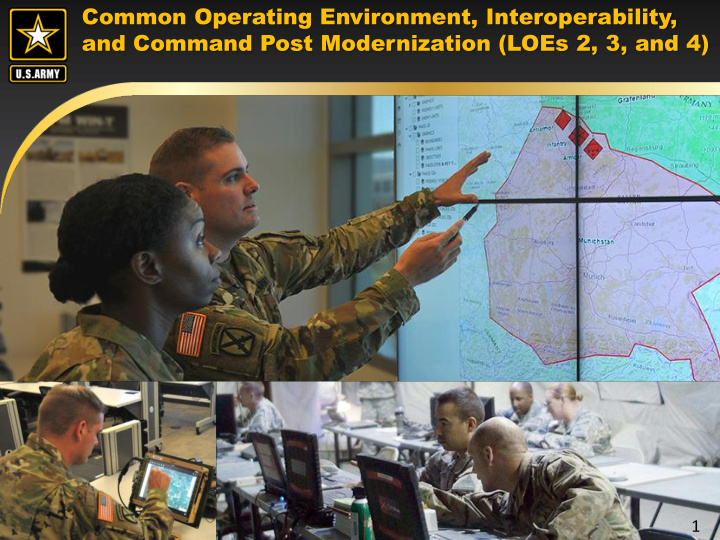



Common Operating Environment, Interoperability, and Command Post Modernization (LOEs 2, 3, and 4) 1
CSA’s Principles, Characteristics and Requir and R equiremen ements ts Warfighting Technical Network Characteristics of the Principles (Why) Network Requirements Requirements Able to fight, shoot, Simple and Intuitive, single Must be capable of adequate Mission: TheArmy must fight and win wars against move, communicate, mission command suite secure communications, provides adversari es… (Single COP), installed, protect, and sustain voice, data, video in all operated and maintained by environments 1 st Principles: The Army Soldiers Reliably communicate Capable of providing situational Available, Reliable and network must enable: anywhere, anytime, in awareness down to Platoon level Resilient with the ability to Device works anywhere in the all domains, in all operate in all operational 1. Conduct of War: Execution environments, against world; installed, operated and environments against any of expeditionary, world-wide, any foe maintained by Soldiers enemy Standardized: Runs on a COE, Unified Land Operations Expeditionary and Mobile, (ULO) to shape, prevent, and common graphics, applications, voice, data, and video on the win as a part of UnifiedAction and integrated data move Ensures continuous Joint in all domains and all Standards-based, protected, environments (Note 1/2/3/4) interoperability enabling agile and and dynamic network that is adaptable operational flexibility upgradeable over time i.e., Enables Rapid T 2. Preparation for War: ask Enables the Warfighter to Execution of Title 10 Organization and employment Observe, orient, decide, and responsibilities to man, train, of joint capabilities act faster than the enemy in Mitigates electronic signature and equip the force, and to the conduct of ULO (Note Accessible to allies and coalition build and sustain readiness. 4) partners Note 1: Unified Actions Partners – Enables use of the network Consisting of Joint, Interagency, as a weapon system Intergovernmental, and Multi- Enables leaders to lead and National (JIIM) partners fight their formations from Note 2: Domains – Land, maritime, anywhere they choose air, space, cyber Note 3: Environments – Permissive, Note 4: ULO – Simultaneous offense, defense, and stability or defense support of civil authorities tasks to seize, retain, and exploit the initiative and consolidate gains to prevent conflict, shape the operational environment and non- permissive, contested, denied win our nations wars as part of unified action
Missio Mission n Comman Command d Systems Systems Current • Different User Interfaces CPOF • Different Maps TIGR • Different Training CMD WEB • Different Hardware JBC-P AFATDS DCGS-A AMDWS WfF Apps AMPS GCCS-A TAIS Etc … Future • Common User Interface • Single Shareable Geospatial Foundation • Transferable Training • Common Hardware
Common Oper Common Operating En ting Envir vironment onment (COE) (COE) From disparate SW & HW platform s To common SW onto common HW devices INDUSTRY MODEL In your pocket In the office/home On the road Applications owned developing companies but reside on computing devices INDUSTRY MODEL APPLIED TO ARMY Dismounted Command Post Applications developed by original PEOs, but reside on Mounted CPCE/MCE CPCE will provide an intuitive user experience for Movement and Maneuver Applications while setting conditions for additional Warfighting Functions to converge from stovepipped systems to integrated applications.
Command Comman d Post ost Impr Improvemen ements ts Future CP Characteristics Unit Initiatives Hosts COE Applications Expeditionary Agile Scalable Integrated Designs Reduced Footprint Mobile Energy Efficient Formation Appropriate Survivable CPI2 Objective Current Program of Record 5
The Multiple he Multiple Lay Layer ers s to to Inter Interoper operability bility Challenges Challenges Levels of Interoperability At what level is the information protected? Deconflicted Compatible Integrated Aligned capabilities and Effective interaction and Network enabled procedures, no interaction complimentary processes full interoperability Top Secret Types of Partners? Secret ABCANZ Joint Allies/Parnters/Others Inter-Org goal is an USAF ABCANZ USG IA SEC//REL integrated 2-star HQ USMC ROK MN GOV for LSCO Secure UNCLASS USN NATO HN GOV NLT 2020 SOF Others NGOs Unclassified At Echelons? Theater Army Corps Division Brigade Battalion Across the Range of Military Operations (ROMO) Mil. Engagement/Security Coop./Deterrence Crisis Response/Limited Contingency Large Scale Combat Operations (LSCO) Interoperability across the various Warfighting Functions? Mission Command Movement & Maneuver Fires Intelligence Sustainment Protection Priorities? Non-negotiable Areas? Forcing Functions? UNCLASSIFIED 2
Path F th Forw orwar ard Key Interoperability Opportunity Events (Campaign of Learning) WFX 18.4 USAREUR All things CTC Rotations JWA 18.1 Saber Pacific Strike Army, Joint, JWA 19.1 All things Combined Pacific Informs longer term efforts Exercises Objectives Cross Functional Teams CONUS MPE MPE Digital COP MPE Core Services Digital Fires ISR/Intel Fusion Digital Fires Secure Tactical Voice Key Sustainment ISR/Intelligence Fusion Capabilities Secure Tactical Voice Key Sustainment Capabilities Decision Drivers MC Interoperability White Paper Determining Levels of Interoperability (Prioritized 1-N List) Interoperability Proponency Governance/Framework Deconflicted Compatible Integrated Full DOTMLPF-P Analysis UNCLASSIFIED 7
Ho How Indu w Industr stry y Can Can Par articipa ticipate te Start with Software Development Kits (SDK), they describe: • CPCE/MCE architecture and components for infrastructure, core utilities and MC applications. Data strategy and the ways to extend it. • The strategy to achieve common look and feel with specific examples. • How 3 rd party developers can work convergence including Data Architecture, User Interface, Geospatial and HW perspective. • Command Post solutions in support of CSA principles, characteristics, and requirements. • Interoperability solutions that increase Unified Partner access to Mission Command Systems.
Recommend
More recommend